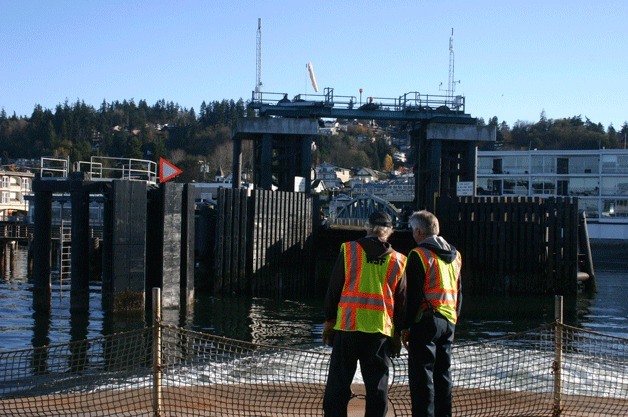Breathe easy, South Whidbey ferry commuters. Edmonds and Everett are off the table.
Planners looking long-range at the Mukilteo Ferry Terminal have decided, by popular demand, that it won’t be moved to either dreaded E-city, which would nearly triple the crossing time.
“People made it easy to make the decision,” Hadley Rodero, a Washington State Ferries consultant in Seattle, said Thursday. “The comments all headed in the same direction — they didn’t want Edmonds or Everett.”
Those sites were among nine options for the ferry terminal suggested by planners during the ferry system’s preliminary community outreach phase conducted this past fall for a project that wouldn’t be completed for at least another nine years.
That list of options has been whittled to four, Rodero said.
Included are two proposals for the Elliott Point area just northeast of downtown Mukilteo. The area is more familiar as the location of a World War II military fuel-tank farm and is currently owned by the Air Force.
“These options were the most popular,” Rodero said.
The other two options still being considered are upgrading the existing terminal, or doing nothing, she said. The latter is a requirement by state and federal agencies as a baseline for comparison, she added.
Rodero said the list was pared after planners received 365 written comments from the public, letters from 20 agencies and input from a series of community meetings held in cities and towns touched by the Clinton-Mukilteo ferry route.
Comments were also sought from 13 Native American tribes in the region, Rodero said. Elliott Point is the site of the Point Elliott Treaty, a land-settlement agreement signed on Jan. 22, 1855 by U.S. government officials and tribal members two years after Washington Territory was formed.
The tribes contacted, including the Tulalips, were among the original signees of the treaty, she said.
Rodero said tribal officials recognized that moving the ferry terminal to the site would be an opportunity to promote the area’s historic significance in a positive way through naming, signs and other informative displays.
“That feedback was consistent from the tribes we heard from,” she said.
The Clinton-Mukilteo ferry route, the second busiest for vehicle traffic behind Seattle-Bainbridge Island, and the third largest in annual ridership in the ferry system, is a major section of well-traveled State Route 525.
Planners say future usage of the route is expected to increase 73 percent by 2030.
The Mukilteo terminal has had no significant improvements since the early 1980s. Its cramped layout makes it difficult for passengers to get in and out of the terminal, and contributes to traffic congestion, safety concerns and conflicts between vehicle and pedestrian traffic.
They say the goal is to reduce congestion, improve operations and safety and to accommodate other modes of transportation, especially buses and trains.
Earlier planning for the future of the terminal was suspended by the state Legislature in 2007, for funding and other reasons. It was reauthorized in 2009.
Current approved funding for the project is $63 million, Rodero said, adding that additional federal funds will be required to complete it.
The timetable calls for public comments collected and an environmental impact statement obtained by 2012, a design completed by 2015 and construction completed by 2019.
Rodero said that in the coming year, the ferry system will study the remaining options in more detail, then prepare a draft environmental impact statement. Another public comment period would follow in the fall.
“People will be able to weigh in on the project again,” she promised.
For information about the project, view the latest report.



